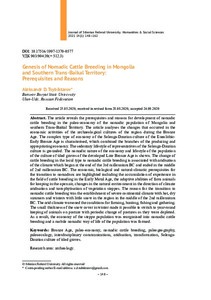Показать сокращенную информацию
Genesis of Nomadic Cattle Breeding in Mongolia and Southern Trans-Baikal Territory: Prerequisites and Reasons
| Автор | Tsybiktarov, Aleksandr D. | en |
| Автор | Цыбиктаров, А. Д. | ru_RU |
| Дата внесения | 2020-10-20T02:44:59Z | |
| Дата, когда ресурс стал доступен | 2020-10-20T02:44:59Z | |
| Дата публикации | 2020 | |
| URI (для ссылок/цитирований) | https://elib.sfu-kras.ru/handle/2311/137511 | |
| Аннотация | The article reveals the prerequisites and reasons for development of nomadic cattle breeding in the paleo-economy of the nomadic population of Mongolia and southern Trans-Baikal Territory. The article analyses the changes that occurred in the economic activities of the archaeological cultures of the region during the Bronze Age. The complex type of economy of the Selenga-Daurian culture of the Eneolithic-Early Bronze Age is characterised, which combined the branches of the producing and appropriating economy. The sedentary lifestyle of representatives of the Selenga-Daurian culture is grounded. The nomadic nature of the economy and lifestyle of the population of the culture of tiled graves of the developed Late Bronze Age is shown. The change of cattle breeding in the local type to nomadic cattle breeding is associated with aridisation of the climate which began at the end of the 3rd millennium BC and ended in the middle of 2nd millennium BC. The economic, biological and natural-climatic prerequisites for the transition to nomadism are highlighted including the accumulation of experience in the field of cattle breeding in the Early Metal Age, the adaptive abilities of farm animals for keeping in the open air, changes in the natural environment in the direction of climate aridisation and xerophytisation of vegetation steppes. The reason for the transition to nomadic cattle breeding was the establishment of severe continental climate with hot, dry summers and winters with little snow in the region in the middle of the 2nd millennium BC. The arid climate worsened the conditions for farming, hunting, fishing and gathering. The small thickness of the snow cover in winter made it possible to switch to year-round keeping of animals on pasture with periodic change of pastures as they were depleted. As a result, the economy of the steppe population was reorganised into nomadic cattle breeding and a mobile nomadic way of life of the population was formed | en |
| Аннотация | Раскрыты предпосылки и причины становления кочевого скотоводства в палеоэкономике степного населения Монголии и Южного Забайкалья. Проанализированы изменения, произошедшие в хозяйственных занятиях археологических культур региона на протяжении эпохи бронзы. Дана характеристика комплексного типа экономики населения селенгинско-даурской культуры времени энеолита – ранней бронзы, сочетавшей отрасли производящего и присваивающего хозяйства. Обосновано положение об оседлом образе жизни представителей селенгинско-даурской культуры. Показан номадный характер хозяйства и образа жизни населения культуры плиточных могил времени развитой – поздней бронзы. Смена скотоводства придомного типа кочевым скотоводством связана с аридизацией климата, начавшейся в конце III тыс. до н.э. и завершившейся в середине II тыс. до н.э. Выделены экономические, биологические и природно-климатические предпосылки перехода к номадизму, в том числе накопление опыта в сфере скотоводства в эпоху раннего металла, адаптационные способности разводимых домашних животных к содержанию под открытым небом, изменения в окружающей природной среде в направлении аридизации климата и ксерофитизации растительности степей. Причиной перехода к кочевому скотоводству было установление в регионе в середине II тыс. до н.э. резко континентального климата с жарким сухим летом и малоснежными зимами. Засушливый климат ухудшил условия для занятия земледелием, охотой, рыболовством и собирательством. Небольшая толщина снежного покрова в зимнее время позволила перейти к круглогодичному содержанию животных на подножном корму с периодической сменой пастбищ по мере их истощения. В итоге произошла перестройка экономики степного населения на ведение кочевого скотоводства и сформировался подвижный номадный образ жизни населения | ru_RU |
| Язык | en | en |
| Издатель | Сибирский федеральный университет. Siberian Federal University | en |
| Тема | Bronze Age | en |
| Тема | paleo-economy | en |
| Тема | nomadic cattle breeding | en |
| Тема | paleogeography | en |
| Тема | paleoecology | en |
| Тема | interdisciplinary communications | en |
| Тема | aridisation | en |
| Тема | transformation | en |
| Тема | Selenga-Daurian culture of tiled graves | en |
| Тема | бронзовый век | ru_RU |
| Тема | палеоэкономика | ru_RU |
| Тема | кочевое скотоводство | ru_RU |
| Тема | палеогеография | ru_RU |
| Тема | палеоэкология | ru_RU |
| Тема | междисциплинарные связи | ru_RU |
| Тема | аридизация | ru_RU |
| Тема | трансформация | ru_RU |
| Тема | селенгинско-даурская культура плиточных могил | ru_RU |
| Название | Genesis of Nomadic Cattle Breeding in Mongolia and Southern Trans-Baikal Territory: Prerequisites and Reasons | en |
| Альтернативное название | Генезис кочевого скотоводства в Монголии и Южном Забайкалье: предпосылки и причины | ru_RU |
| Тип | Journal Article | en |
| Контакты автора | Tsybiktarov, Aleksandr D.: Banzrov Buryat State University Ulan-Ude, Russian Federation; a.d.tsibiktarov@gmail.com | en |
| Контакты автора | Цыбиктаров, А. Д.: Бурятский государственный университет им. Доржи Банзарова Российская Федерация, Улан-Удэ | ru_RU |
| Страницы | 148–162 | |
| DOI | 10.17516/1997-1370-0577 | |
| Журнал | Журнал Сибирского федерального университета. Гуманитарные науки. Journal of Siberian Federal University. Humanities & Social Sciences 2021 14(1) | en |

